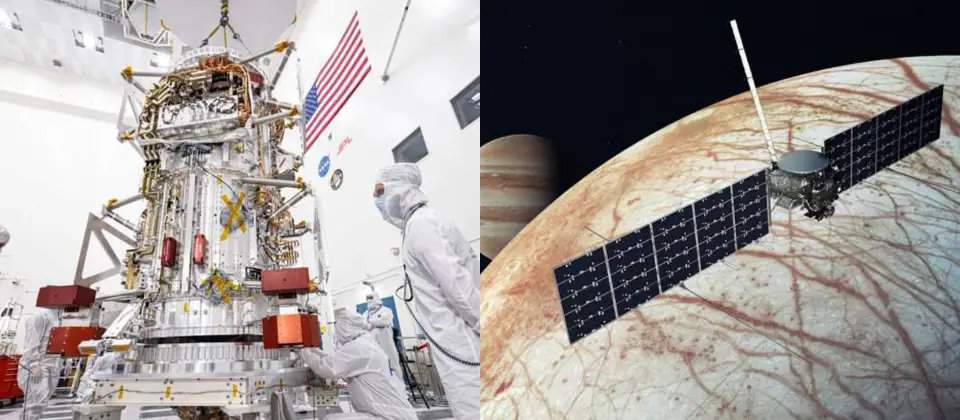Previous mission to Europa has shown that Jupiter’s icy moon may contain a subsurface ocean that could exist as liquid water. Since scientists have discovered that some form of lifeforms could be present on celestial bodies with water, space agencies have been curious to study Europa surface and its subsurface ocean.
During a recent observation, NASA’s James Webb Space Telescope (JWST) observed the icy moon of Jupiter from the L2, the second sun-Earth Lagrange point. Webb discovered the existence of carbon in the subsurface ocean of Europa, which stands as one of the top building blocks for life. Scientists were amazed by this discovery as it is opening doors to advancing the search for extraterrestrial lifeforms.
“On Earth, life likes chemical diversity – the more diversity, the better. We’re carbon-based life. Understanding the chemistry of Europa’s Ocean will help us determine whether it’s hostile to life as we know it or if it might be a good place for life,” said Geronimo Villanueva of NASA’s Goddard Space Flight Center in Greenbelt, Maryland, in an official statement.
What Scientists Think About The Origin of the Carbon Found on Europa Surface
Past observations have revealed that solid carbon dioxide (CO2) ice exists on the Europa surface. However, scientists have been finding it challenging to tell if this CO2 ice came from eruptions from Europa’s subsurface ocean or if they were deposited via meteorite impacts on the surface of the icy moon. Scientists used Webb’s sensitivity to map out the distribution of CO2 on Europa’s surface. The researchers conducted the mapping in great detail.
They also studied in detail the data of one of the most important young geological features on the icy moon named Tara Regio or Chao Terrain. Scientists have discovered that fractured frozen plates and blocks covered this region of about 695 square miles (1,800 square km). Unlike most parts of Europa, this region is unique as it comprises of smoother surface encompassing it.
Based on our scientific exploration of the solar system, scientists have concluded that Europa has the smoothest surface. The icy moon possesses an infant ice surface containing minimal impact craters. Hence, its face suggests that geological activity is currently active on the moon’s surface. Webb discovered that an abundant amount of CO2 exists in this region. Further observation verified that this carbon has been piling up from the salty ocean that lies beneath the icy surface moon.
“Previous observations from the Hubble Space Telescope show evidence for ocean-derived salt in Tara Regio. Now we’re seeing that carbon dioxide is heavily concentrated there as well. We think this implies that the carbon probably has its ultimate origin in the internal ocean,” said Samantha Trumbo of Cornell University in Ithaca, New York.
How JWST Made This Fascinating Discovery
JWST spent a few minutes studying Europa before making this fascinating discovery for humanity. After Webb’s space telescope had captured the new details of Europa, two separate independent teams studied the obtained data and published their findings in the journal Science.
The two teams discovered the presence of carbon dioxide after studying the data captured from the integral field unit of Webb’s Near-Infrared Spectrograph (NIRSpec). Astronomers were able to determine the exact locations of specific compounds on the icy moon’s surface with the provided data.
“These observations only took a few minutes of the observatory’s time. Even with this short period, we were able to do really big science. This work gives a first hint of all the amazing solar system science we’ll be able to do with Webb,” said Heidi Hammel of the Association of Universities for Research in Astronomy.
In addition, scientists suggest that any celestial body with the presence of life on its surface must possess a habitable environment including liquid water, a source of energy, and the perfect chemistry. Based on the scientific exploration on Europa, scientists discovered that the icy moon possesses these ingredients. Hence, future missions to Europa including NASA’s Europa Clipper mission, the European Space Agency’s Jupiter Icy Moons Explorer (JUICE) spacecraft, and many others will enable scientists to learn more about the icy moon.
Conclusion
While making a recent observation, NASA’s James Webb Space Telescope discovered carbon on the Europa surface. This fascinating discovery is about helping scientists in planning for future missions to Jupiter’s icy moon. What do you think about this fascinating discovery? In addition, you can check out these books every space lover should read.




